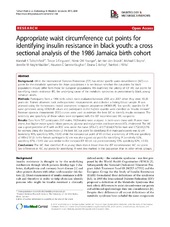| dc.contributor.author | Tulloch-Reid, Marshall K. | en_US |
| dc.contributor.author | Ferguson, Trevor S. | en_US |
| dc.contributor.author | Younger, Novie O. M. | en_US |
| dc.contributor.author | Van den Broeck, Jan | en_US |
| dc.contributor.author | Boyne, Michael S. | en_US |
| dc.contributor.author | Knight-Madden, Jennifer M. | en_US |
| dc.contributor.author | Samms-Vaughan, Maureen E. | en_US |
| dc.contributor.author | Ashley, Deanna | en_US |
| dc.contributor.author | Wilks, Rainford J. | en_US |
| dc.date.accessioned | 2011-04-07T09:32:49Z | |
| dc.date.available | 2011-04-07T09:32:49Z | |
| dc.date.issued | 2010-12-07 | eng |
| dc.Published | Diabetology & Metabolic Syndrome 2:68 | en_US |
| dc.identifier.issn | 1758-5996 | |
| dc.identifier.uri | https://hdl.handle.net/1956/4634 | |
| dc.description.abstract | Background While the International Diabetes Federation (IDF) has ethnic specific waist circumference (WC) cut-points for the metabolic syndrome for Asian populations it is not known whether the cut-points for black populations should differ from those for European populations. We examined the validity of IDF WC cut points for identifying insulin resistance (IR), the underlying cause of the metabolic syndrome, in predominantly black, young Jamaican adults. Methods Participants from a 1986 birth cohort were evaluated between 2005 and 2007 when they were 18-20 years old. Trained observers took anthropometric measurements and collected a fasting blood sample. IR was assessed using the homeostasis model assessment computer programme (HOMA-IR). Sex specific quartiles for IR were generated using HOMA-IR values and participants in the highest quartile were classified as "insulin resistant". Receiver operator characteristic (ROC) curves were used to estimate the best WC to identify insulin resistance. The sensitivity and specificity of these values were compared with the IDF recommended WC cut-points. Results Data from 707 participants (315 males; 392females) were analysed. In both sexes those with IR were more obese, had higher mean systolic blood pressure, glucose and triglycerides and lower mean HDL cholesterol. The WC was a good predictor of IR with an ROC area under the curve (95% CI) of 0.71(0.64,0.79) for men and 0.72(0.65,0.79) for women. Using the Youden Index (J) the best WC cut point for identifying IR in male participants was 82 cm (sensitivity 45%, specificity 93%, J 0.38) while the standard cut point of 94 cm had a sensitivity of 14% and specificity of 98% (J 0.12). In the female participants 82 cm was also a good cut point for identifying IR (sensitivity 52%, specificity 87%, J 0.39) and was similar to the standard IDF 80 cm cut point (sensitivity 53%, specificity 82%, J 0.35). Conclusions The WC that identified IR in young black men is lower than the IDF recommended WC cut point. Sex differences in WC cut points for identifying IR were less marked in this population than in other ethnic groups. | en_US |
| dc.language.iso | eng | eng |
| dc.publisher | BioMed Central | eng |
| dc.rights | Attribution CC BY | eng |
| dc.rights.uri | http://creativecommons.org/licenses/by/2.0 | eng |
| dc.title | Appropriate waist circumference cut points for identifying insulin resistance in black youth: a cross sectional analysis of the 1986 Jamaica birth cohort | en_US |
| dc.type | Peer reviewed | |
| dc.type | Journal article | |
| dc.description.version | publishedVersion | en_US |
| dc.rights.holder | Copyright 2010 Tulloch-Reid et al; licensee BioMed Central Ltd. | |
| dc.rights.holder | Tulloch-Reid et al. | |
| dc.identifier.doi | https://doi.org/10.1186/1758-5996-2-68 | |
| dc.identifier.cristin | 835036 | |

